White flowering trees are a mesmerizing gift bestowed upon us by nature. They grace our world with a harmonious ensemble of vibrant white hues and captivating fragrances. Found across the globe, these extraordinary trees and their white blossoms adorn our landscapes with a rich tapestry of diverse shapes, sizes, and shades. These majestic trees possess not only immense aesthetic appeal but also play a vital role in purifying our air, reducing noise, and facilitating crucial pollination. The various species of white flowering trees contribute significantly to enriching and harmonizing our environment. Below is a selection of these breathtaking tree marvels, inviting us to appreciate their splendor and embrace their ecological importance.
1. Blossom Yellowhorn (Xanthoceras Sorbifolium)
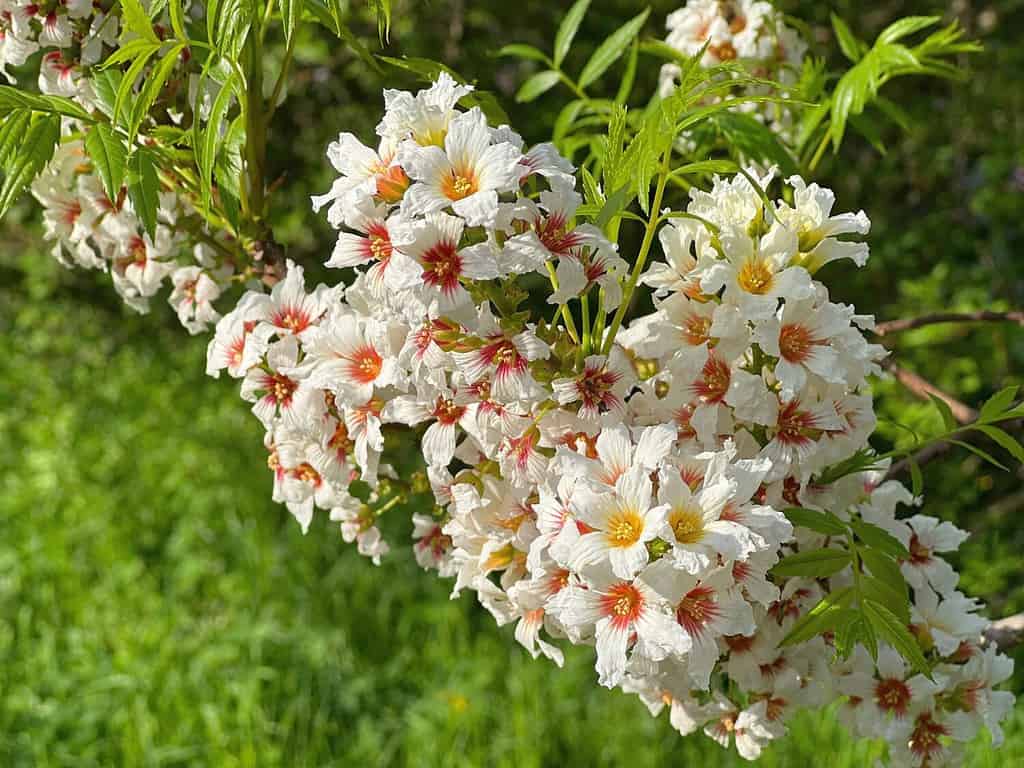
In spring, blossom yellowhorn blooms with clusters of star-shaped white flowers with yellow or red centers.
©lialina/Shutterstock.com
The blossom yellowhorn is a cherished deciduous tree native to northern China. Also known as the shiny leaf yellowhorn or Chinese flowering chestnut, this plant belongs to the Sapindaceae family, which includes maples, lychees, and pistachios. Standing at 20 to 25 feet tall, it has a spreading, rounded crown, and smooth gray bark. Its compound leaves with glossy green leaflets turn brilliant yellow in the fall. In spring, it blooms with clusters of star-shaped white flowers with yellow or red centers. These are followed by non-consumable green fruits resembling buckeyes. The blossom yellowhorn thrives in various soil types and conditions, preferring full sun exposure and well-drained soil. It is drought-tolerant and resistant to pests and diseases, making it hardy and long-lasting.
2. Common Dogwood (Cornus Sanguinea)
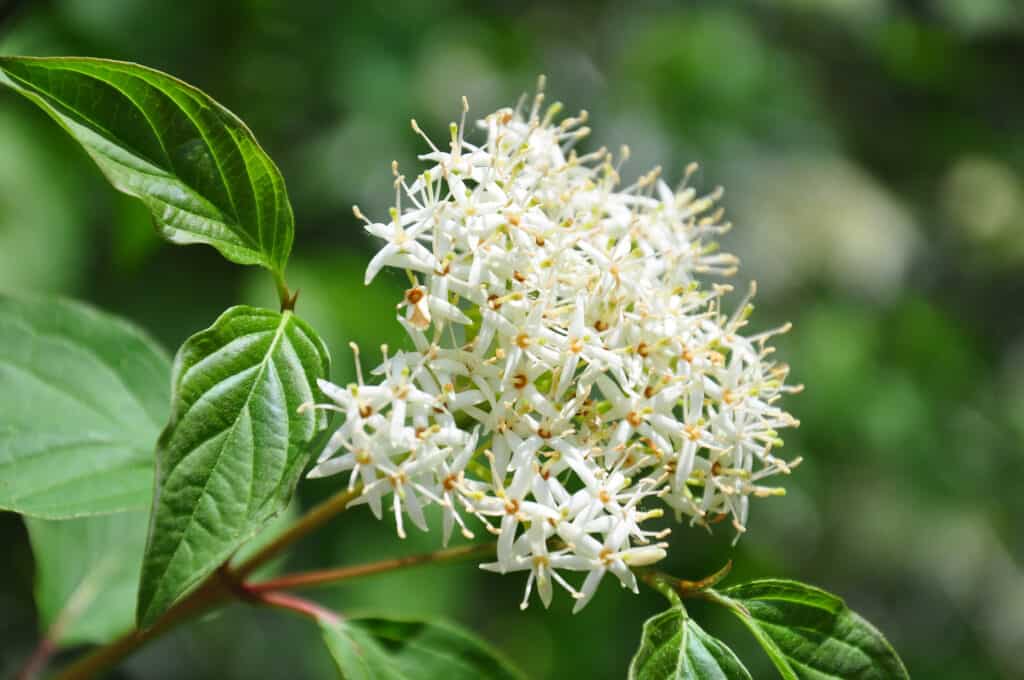
Once spring arrives, the dogwood tree unveils its clusters of delicate, creamy-white flowers that effortlessly catch the eye.
©iStock.com/rbiedermann
The common dogwood is part of the genus Cornus, a group of exquisite trees and shrubs cherished for their enchanting flowers. Native to Europe and western Asia, the dogwood tree is a deciduous shrub or small tree that is widely cultivated as an ornamental plant across the globe. With an average height ranging between 8 to 15 feet, these majestic trees can reach up to 20 feet at their peak. Their blossoms, serving as a treat for pollinating insects, later transform into dainty blackberries, eagerly devoured by birds and mammals alike. Several dogwood species, such as the Kousa dogwood (Cornus kousa), the flowering dogwood (Cornus florida), and the Japanese dogwood (Cornus alternifolia), hold a special place in the hearts of enthusiasts due to their stunning white blossoms.
3. Japanese Dogwood (Cornus alternifolia)
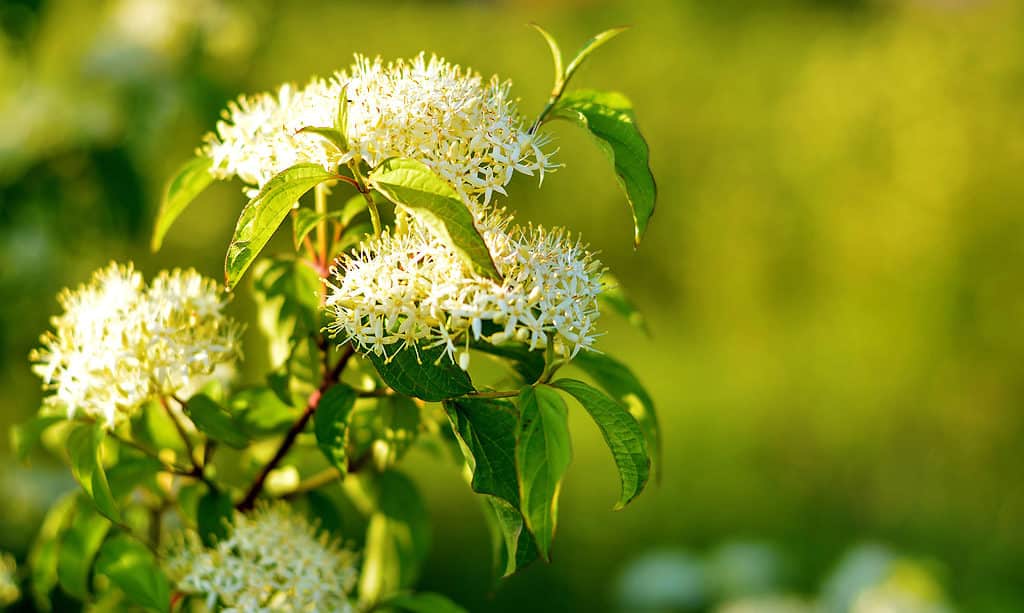
The Japanese dogwood is also known as the pagoda dogwood.
©iStock.com/izzzy71
The Japanese dogwood is a small, deciduous tree native to East Asia. It is a popular ornamental tree in many parts of the world, prized for its unique tiered branching habit, showy flowers, and attractive foliage. Japanese dogwood trees typically grow 15 to 25 feet tall and wide, with a horizontal branching habit that forms tiers. In the spring, the tree produces clusters of small, creamy-white flowers that are borne in flat-topped clusters. The flowers are not as showy as the flowers of some other dogwood species, but they are still attractive and add interest to the landscape. In the summer, the Japanese dogwood produces bluish-black fruits that are edible but not particularly tasty. Fruits are a popular food source for birds and other wildlife. In the fall, the leaves turn a brilliant red-purple color before falling to the ground.
4. Kousa Dogwood (Cornus kousa)

The white blossoms of Kousa Dogwood transform into fruit, a colorful contrast against the leaves.
©Iryna Imago/Shutterstock.com
The captivating Kousa dogwood adorns the landscape with its delicate white flowers. These exquisite blooms usually make their appearance in late spring, following the emergence of the leaves. These flowers play host to insect pollinators, serving as a gateway to the raspberry-like fruits that dot the tree’s canopy come summer. Although the flowers themselves are small and unassuming, they are encircled by four white bracts often mistaken for petals. These bracts are what truly embellish the Kousa dogwood, bestowing upon it a captivating display of snowy blooms. It is no wonder that Kousa dogwood trees have gained esteem as popular ornamental choices, cherished for their showy flowers, captivating foliage, and year-round allure. Moreover, these trees offer the added benefits of low-maintenance care and resilience against various pests and diseases, further solidifying their coveted status in many regions across the globe.
5. Flowering Dogwood (Cornus florida)
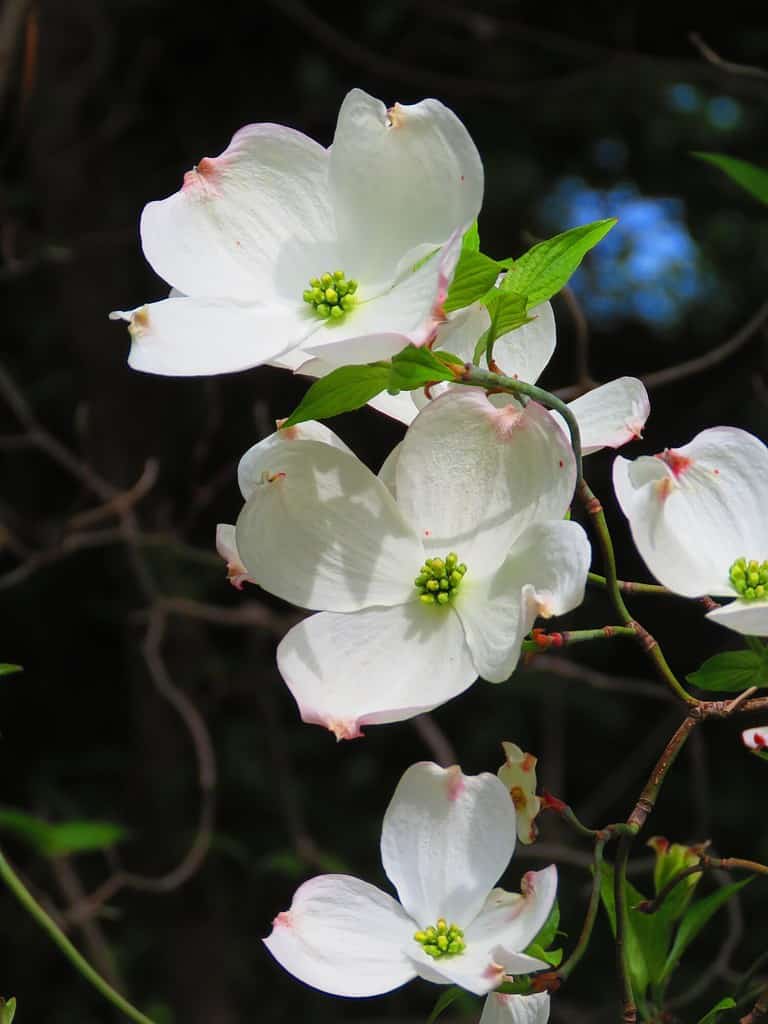
Native to eastern North America, the flowering dogwood is a deciduous tree.
©Przemyslaw Muszynski/Shutterstock.com
The flowering dogwood is a small deciduous tree native to eastern North America. With its showy flowers, attractive foliage, and year-round appeal, it has become a prized ornamental tree worldwide. Growing 15 to 25 feet tall and wide, the flowering dogwood boasts opposite, oval-shaped leaves of a deep green hue. In early spring, clusters of four white bracts encircle inconspicuous yellow-green flowers, often mistaken for petals. These beautiful blooms precede the emergence of leaves. As summer arrives, the flowering dogwood tree bears red drupes that, while not particularly delectable, serve as a popular food source for birds and other wildlife. In autumn, the leaves transform into a brilliant shade of red-purple before gracefully descending to the ground.
6. Canadian Dogwood (Cornus Canadensis)
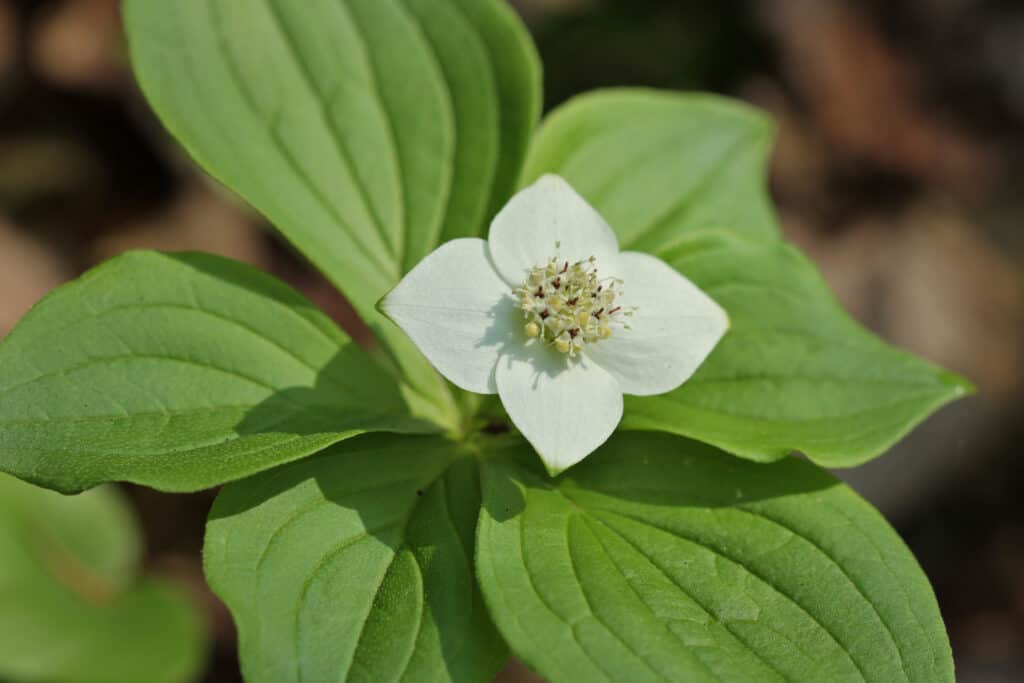
Historically, the resilient and sturdy wood of Canadian dogwood has been used to create tool handles and various small items.
©iStock.com/Yves Dery
The Canadian dogwood is a small deciduous shrub native to Canada and the northern United States. It is a slow-growing shrub that typically reaches a height of 3 to 6.5 feet. It has a rounded, spreading habit and is characterized by four large white bracts surrounding a cluster of small greenish flowers. The shrub blossoms in the spring, mainly in May or June, accompanied by the production of edible yet moderately flavored red berries. Renowned for its ornamental characteristics, the Canadian dogwood thrives in both landscaped and naturalized environments such as woodlands and meadows. It also serves as a host plant for dogwood borer moth larvae.
7. Fringe Tree (Chionanthus virginicus)

The
Fringe tree
is an alluring deciduous tree that leaves a profound impression.
©Kristine Radkovska/ via Getty Images
The fringe tree (Chionanthus virginicus) is a small, deciduous tree native to the eastern United States. It gets its name from the delicate, white flowers that hang in long, drooping clusters, resembling fringes. The genus name, Chionanthus, stems from the Greek words chion (snow) and anthos (flower), while the species name, virginicus, reflects its native range. This remarkable tree is highly esteemed by landscapers and cherished by nature enthusiasts for good reason. Its branches are adorned with exquisite elongated white blossoms that exhibit unparalleled adaptability to diverse environmental conditions. The fringe tree effortlessly thrives with minimal upkeep.
8. Cucumber Tree (Magnolia Acuminata)
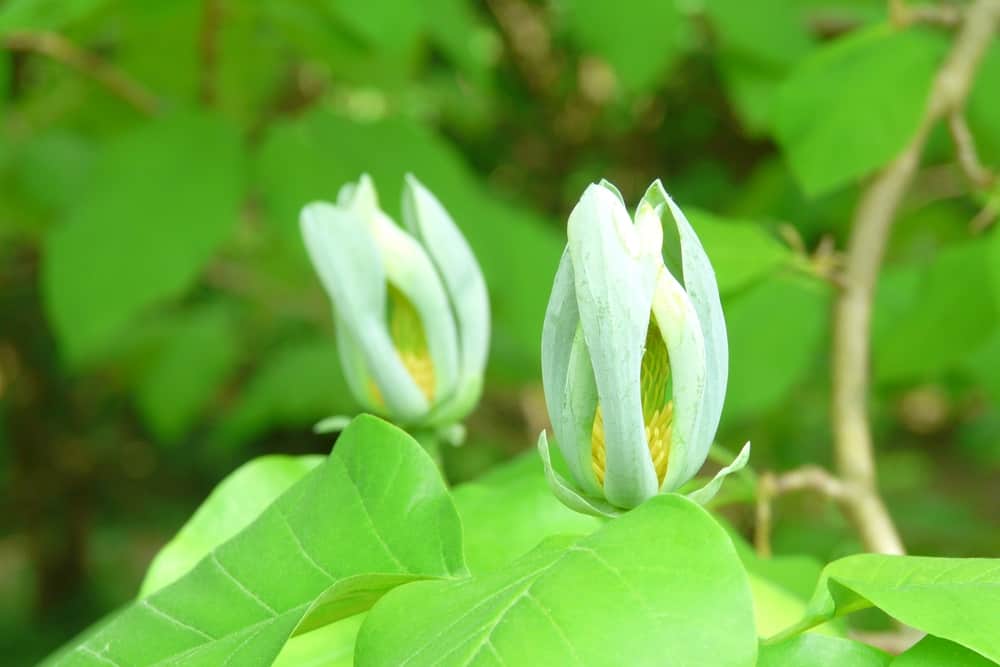
Cucumber trees have beautiful tulip-like white flowers.
©Anna Krzywania/Shutterstock.com
The cucumber tree is also called cucumber magnolia or blue magnolia. It is a magnificent deciduous tree native to eastern North America. Thriving in diverse environments from forests to slopes, this tree can reach a height of up to 75 feet with a broad crown. Its substantial ovate leaves can grow up to 10 inches long, showcasing a deep green color in summer and transforming into vibrant yellow in autumn. In late spring, the tree’s captivating blossoms emerge, resembling delicate tulips with greenish-yellow or yellowish-white tones. Though lacking fragrance, these blooms still attract bees and butterflies due to their elongated size of approximately 2 inches. As summer approaches, the tree’s fruit takes center stage, producing cone-shaped aggregates of follicles that turn from green to a stunning red during late summer, indicating their maturation.
9. Fraser Magnolia Tree (Magnolia fraseri)
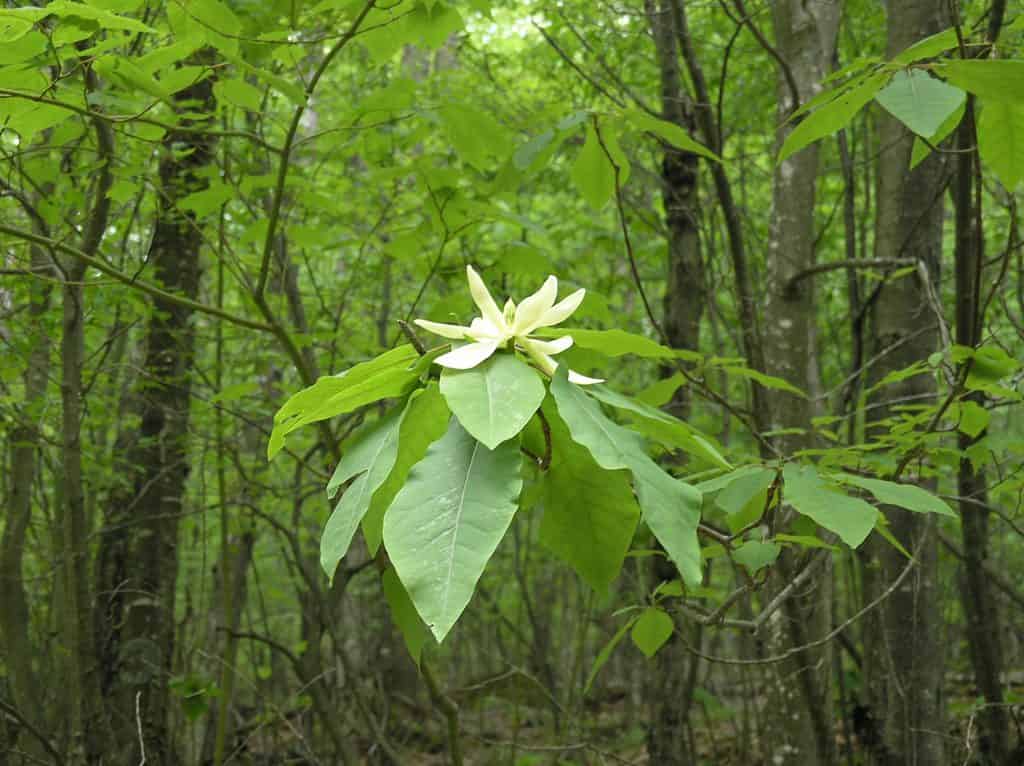
The Fraser magnolia is a deciduous tree that can attain heights of up to 40 feet.
©Richtid / CC BY-SA 3.0, via Wikimedia Commons – Original / License
The Fraser magnolia stands as a majestic tree indigenous to the awe-inspiring southern Appalachian Mountains in the United States. With an imposing height of 30 to 40 feet, it graces the landscape with its modest yet substantial presence. Its leaves, range from 6 to 10 inches in length and 3 to 7 inches in width. During the rejuvenating spring from late April to early May, the Fraser Magnolia shines in all its splendor, showcasing magnificent white flowers that can reach an impressive diameter of 10 inches while exuding a sweet and captivating fragrance. Thriving in well-drained soil abundant in moisture and basking in the radiant sun, the Fraser magnolia, although not a fast grower, defies the constraints of time, with a lifespan that can span across centuries.
10. Sweetbay Magnolia (Magnolia Virginiana)
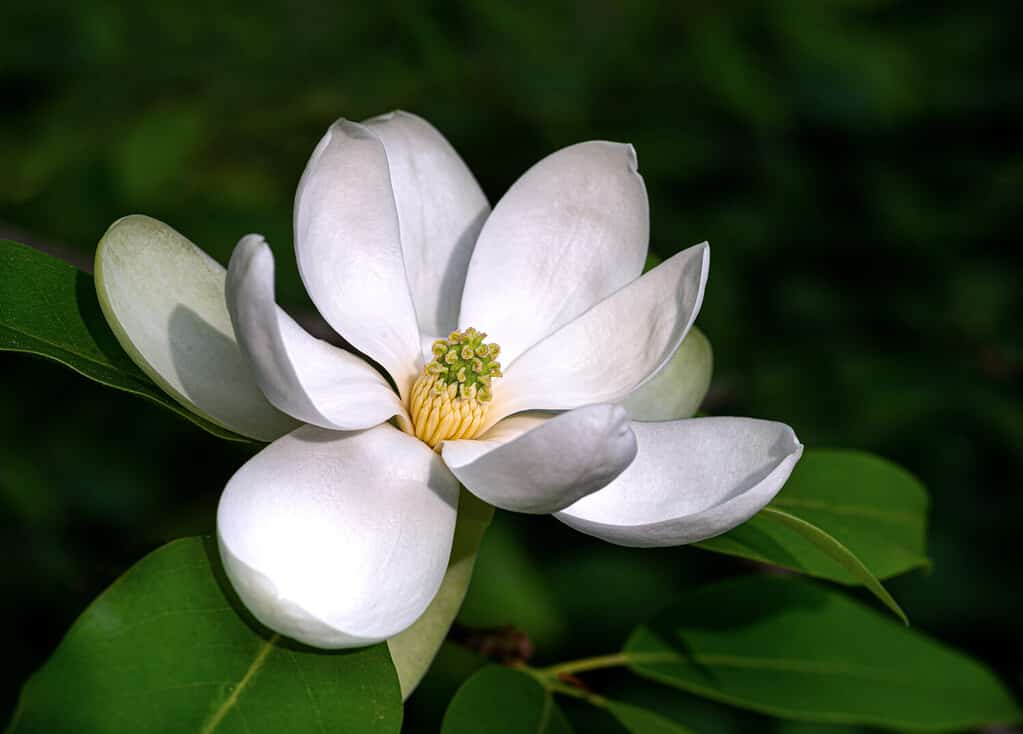
These remarkable trees demonstrate resilience to diverse soil types while flourishing in moisture-rich, acidic conditions.
©Gerry Bishop/Shutterstock.com
The sweetbay magnolia is a deciduous tree or large shrub native to eastern North America. Sweetbay magnolias typically reach heights of 20 to 30 feet and span the same width. The leaves are simple and lanceolate, measuring 3 to 5 inches long. Fragrant and creamy white, the sweet bay magnolia’s cup-shaped flowers span 2 to 3 inches in diameter. Sweetbay magnolias grace landscapes with their beauty, contribute to timber production and even possess medicinal properties. Revered for its sturdy and enduring wood, the Sweetbay Magnolia finds its rightful place in exquisite furniture, elegant flooring, and exquisite paneling.
11. Serviceberry (Amelanchier spp.)
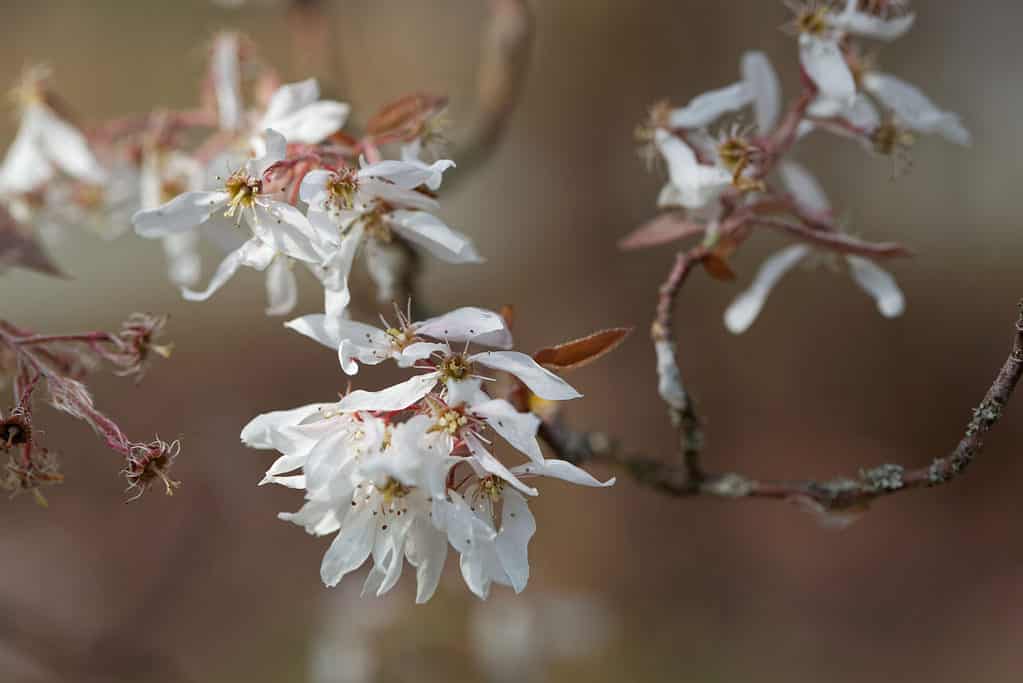
Downy serviceberry fruits are reddish-purple, have an apple-like shape, and ripen in summer.
©iStock.com/weisschr
The serviceberry (Amelanchier spp.) is a magnificent deciduous tree native to North America. With its resplendent clusters of white flowers, the serviceberry tree adds an enchanting touch to the landscape. Serviceberry trees can create a picturesque oasis during the captivating spring season. Their remarkable adaptability and minimal maintenance requirements make them a highly sought-after gem for landscaping projects. The delectable fruits of the serviceberry tantalize the taste buds, offering a myriad of culinary delights, from mouthwatering pies to delightful jams and jellies.
12. Mexican Plum Tree (Prunus Mexicana)

The Mexican plum tree is a deciduous tree native to the central and southern United States, and northern Mexico.
©CinemaPhoto/Shutterstock.com
At the arrival of spring, the Mexican plum tree presents mesmerizing clusters of exquisite white flowers that bloom, emitting a harmonious fragrance that fills the air. Each cluster holds 2 to 5 delicate flowers, displaying the tree’s natural allure. Standing tall at 20 to 30 feet, the Mexican plum tree demands attention with its majestic spread and solitary trunk. As autumn approaches, its leaves transform into a captivating yellow, creating a spectacle that leaves us in awe. The plum fruit, small and round, reaches a diameter of approximately 1 inch as it matures, exhibiting stunning shades of red or purple.
| Number | Common Name | Scientific Name |
|---|---|---|
| 1 | Blossom Yellowhorn | Xanthoceras sorbifolium |
| 2 | Common Dogwood | Cornus sanguinea |
| 3 | Japanese Dogwood | Cornus alternifolia |
| 4 | Kousa Dogwood | Cornus kousa |
| 5 | Flowering Dogwood | Cornus florida |
| 6 | Canadian Dogwood | Cornus canadensis |
| 7 | Fringe Tree | Chionanthus virginicus |
| 8 | Cucumber Tree | Magnolia acuminata |
| 9 | Fraser Magnolia Tree | Magnolia fraseri |
| 10 | Sweetbay Magnolia | Magnolia virginiana |
| 11 | Serviceberry | Amelanchier spp. |
| 12 | Mexican Plum Tree | Prunus mexicana |
The photo featured at the top of this post is © Akif CUBUK/Shutterstock.com
Thank you for reading! Have some feedback for us? Contact the AZ Animals editorial team.







